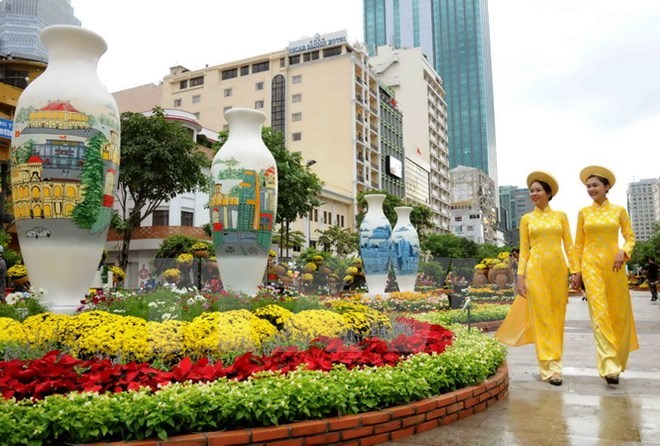
A flower street will be opened on Nguyen Hue pedestrian street in Ho Chi Minh City from February 13 – 19 to welcome the traditional Lunar New Year (Tet) 2018.

A view of Nguyen Hue pedestrian street (Source: VNA)
The annual event, themed "Khat vong vuon xa” (aspiration for further
development), aims to present a city of development and integration, yet
preserving its traditional culture.
The 720 metre-long flower street will be decorated with different flowers
following three sub-themes of the spring in the city, integration and
development, and looking forward to the future.
Meanwhile, the area around the statue of late President Ho Chi Minh will be
covered with yellow apricot (a typical flower during Tet in the south) and
peach (a typical flower during Tet in the north).
Imitations of domestic dogs will be on display at the welcome gate as sacred
animals in the Year of the Dog, while real visual photo-shooting technology
will serve visitors.
This is the 15th version of the flower street to celebrate the traditional
Lunar New Year in the city.
Source: VNA
The People’s Committee of Lac Son district held a ceremony on April 28 to receive the provincial relic certificate for the ancient rock carving site at Suoi Co stream, located in My Thanh commune.
A special music show titled "The country is in the fullness of joy” has been held at Hoa Binh Square in Hoa Binh city in celebration of the 50th anniversary of the liberation of the South and national reunification (April 30, 1975–2025).
The People's Committee of Lo Son commune, Tan Lac district, has organised the local annual traditional stream fishing festival on April 19 - 20.
As a land deeply intertwined with human history and Vietnam’s millennia-long journey of nation-building and defence, Hoa Binh is often revered for its epic tales and legends.
Residents of Hoa Binh boast a rich cultural identity, reflected in their unique language, traditional attire, customs, and folk melodies – described as "sweet as honey, clear as a mountain stream.”
Lac Son district’s Vu ban town held the 2025 Truong Kha temple festival on April 12–13 (the 15th–16th days of the third lunar month). Since its revival in 2019, the festival has been organised every three years, preserving valuable intangible heritage while meeting the community’s cultural and spiritual needs.



